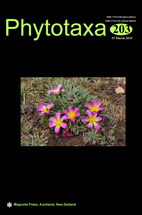Abstract
O. laevimarginata is here described as a new species, and also its asexual morph could not be assigned to an existing taxon. Anamorphic strains were obtained from three teleomorph specimens which were collected at different sites and dates. The anamorph is characterized by cylindric-ellipsoid to oblong conidia, mainly 1-septate, growing either singly or mostly from 2–10 denticles in a capitate arrangement on the tip of conidiophores. These morphological characters are similar to those of the nematophagous anamorph genus Arthrobotrys, but the present isolates lack the ability to produce any trapping devices when contacting with nematodes. Phylogenetic analysis inferred from ITS rDNA sequences on different groups within Orbilia showed that the isolates of O. laevimarginata clustered together in a clade separate from Orbilia crenatomarginata (= Hyalinia crystallina). The two species are close to O. scolecospora and an undescribed species, which all have a crenulate to dentate apothecial margin composed of solid glassy processes. The group clustered distant from those species identified within the nematode-trapping anamorph genera Arthrobotrys, Dactylellina and Drechslerella, but also distant from the non-predacious anamorph genus Dactylella. By combining morphological and phylogenetic analysis, we conclude that the three isolates belong to a single undescribed holomorph species. The morphological differences among the three isolated anamorphic strains, and phylogenetic divergence of nematode-trapping fungi and related species are discussed.

